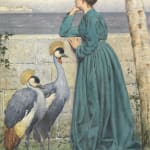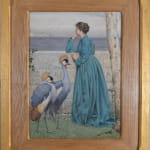Henry Stacey Marks (1825-1898)
Exhibitions
Royal Society of Painters in Water Colours, 1886, no 2 (or 200)
Literature
Hampstead & Highgate Express, 11 December 1886, p 3: " 'Waiting and Watching,' a lady looking serawards, and attended by some tall members of the feathered tribe, noticeable for their noble crests, are most cleverly drawn"
The Times, 2 December 1886, p 8: "Mr Stacy Marks sends ... two other studies of birds - of puffins in a drawing which eh calls 'Three Fishers' (69) and of Cranes in 'Waiting and Watching' (200)"
The Spectator, 18 December, 1886, p 14: "Mr Stacy Marks has gone back to his long-legged and short-legged birds, and sends four compositions in which these are the chief features. The best of these is No. 200, a girl in a blue dress standing "Waiting and Watching," with a couple of long-legged tuft-headed fowls by her side. Not a new style of subject this, for Mr Marks has been at it, with slight variations, for a dozen years at least; but executed with all his skill and thoroughness, and of its semi-humourous kind, good"
In 1877 the Duke of Westminster, to whom Marks had been introduced by the architect Alfred Waterhouse, commissioned Marks to paint a series of 12 panels of birds (including African Cranes) for a drawing room at Eaton Hall in Cheshire. Marks saw the project as 'a fairy garden, an ornithological Walhalla, where no bird quarrels with another, it is content with the climate, conditions, and surroundings of its present abode - an abode where food is always present without the trouble of seeking it'. The walls were covered with grey velvet by Gertrude Jekyll. The recurrent motif in the background of all twelve paintings is a low wall four courses of stone high, and it is likely that this watercolour in some way connects to that project. The identity of the lady is not known; it was unusual for Marks to paint human figures in his pictures (he preferred birds), but she has a strong resemblance to Lady Elizabeth Harriet Grosvenor, the Duke's eldest daughter, who became the Marchioness of Ormonde on her marriage in 1876. Her husband the Marquess was Commodore of the Royal Yacht Squadron and patron of the Dublin Swimming Club, and it is possible that she is watching and waiting for him. The birds are Grey Crowned Cranes, or African Cranes, about a metre high.



